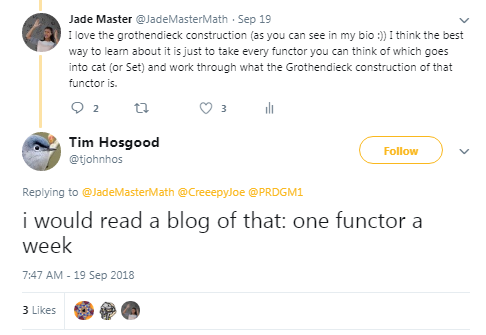Let's Grothendieck Everything in Sight (Week 1)
by Jade Master
I was talking on twitter with Tim Hosgood about how categories without monoidal products tend to represent internal structure (e.g. the free category on a graph, the fundamental groupoid functor, etc.) and categories with a monoidal product often represent external relationships (e.g. Top, Grp, etc. ). Tim asked if there was a nice way to combine these two relationships and I suggested the Grothendieck construction. Tim mentioned that he would like to learn more about the Grothendieck construction so I took this as an opportunity to gush about my favorite thing in category theory.

I think the best way to learn about the Grothendieck construction is to apply it to everything in sight. If you keep doing this, eventually you will start to see it everywhere. Tim suggested that I write a blog about this...so without further ado here it is. One functor a week* until the end of time**
*"week" will be used liberally; I will make a post whenever I have time but I will try to do them weekly.
**I'll make these posts until I don't want to or until they're no longer interesting. This may not be at the same time.
The Definition
The best part of category theory is the definitions. You can find the definition on nLab with varying levels of difficulty. Here is the variant that I suggest starting out with.
Let $ F : C \to \mathsf{Cat}$ be a functor. Then the category $ \int F$ is a category where
- objects are pairs $ (c, x)$ where $ c$ is an object of $ C$ and $ x$ is an object of $ F(c)$ and,
- a morphism from $ (c,x)$ to $ (d,y)$ is a pair $ (f, g)$ where $ f : c \to d$ is a morphism in $ C$ and $ g : F(f)(x) \to y$ is a morphism in $ F(d)$.
- For a morphism $ (f,g) : (c,x) \to (d,y)$ and a morphism $ (h,k) : (d,y) \to (e,z)$ their composite is given by $ (h \circ f, k \circ F(h) (g) )$. In words, you map the morphism $ g$ into the category $ F(e)$ and compose it with $ k$ there.
The intuition is that it takes a functor into $ \mathsf{Cat}$ and smooshes it into a category. This definiton might be confusing before you work out some examples so let's get to it.
Every set is a discrete category. We can use this to get a lot of relatively simple examples of functors into $ \mathsf{Cat}$.
Indeed, let
$ F : X \to \mathsf{Set}$
be a function which assigns a set to every element of $ X$. Then $ F$ can be turned into a functor from $ X$ regarded as discrete category to $ \mathsf{Cat}$ where every set in the image of $ F$ is also regarded as a discrete category. Notice that we don't have to worry about how $ F$ behaves on morphisms because the only morphisms in $ X$ are identity morphisms. These are required by the definition of a functor to map to the identify functions. With $ F$ as above, $ \int F$ is a category where
- objects are pairs $ (c, a)$ where $ c$ is an element of $ X$ and $ a$ is an element of $ F(c)$ and,
- the only morphisms are identity morphisms. Because of this, we might as well think of this Grothendieck construction as a set.
So instead of giving an example, I gave a class of examples. Let's narrow it down further.
Let $ f : X \to Y$ be any function and $ f^{-1} : Y \to \mathsf{Set}$ be the functor (in the sense described above) which sends any element of $ Y$ to the set of elements in its pre-image. Then, $ \int f^{-1}$ is a set where the elements are pairs $ (y,x)$ where $ y \in Y$ and $ x$ is in its pre-image.
This might not be surprising so far...but it shows one way that the Grothendieck construction is used; to unpack the fibres of a functor or function.
Let's narrow it down even further. $ \mathbb{Q}$ is a normal subgroup of $ \mathbb{R}$ so we can form $ \mathbb{R}/\mathbb{Q}$ with the canonical projection $ \pi : \mathbb{R} \to \mathbb{R}/\mathbb{Q}$.
Puzzle 1: What is Grothendieck construction of $ \pi^{-1}$?
Puzzle 2: Conway constructed a function $ f:\mathbb{R} \to \mathbb{R}$ such that the image of every interval $ (a,b)$ is the entire real line. What is the Grothendieck construction of $ f^{-1}$?
I'll post the answers next time.
tags: